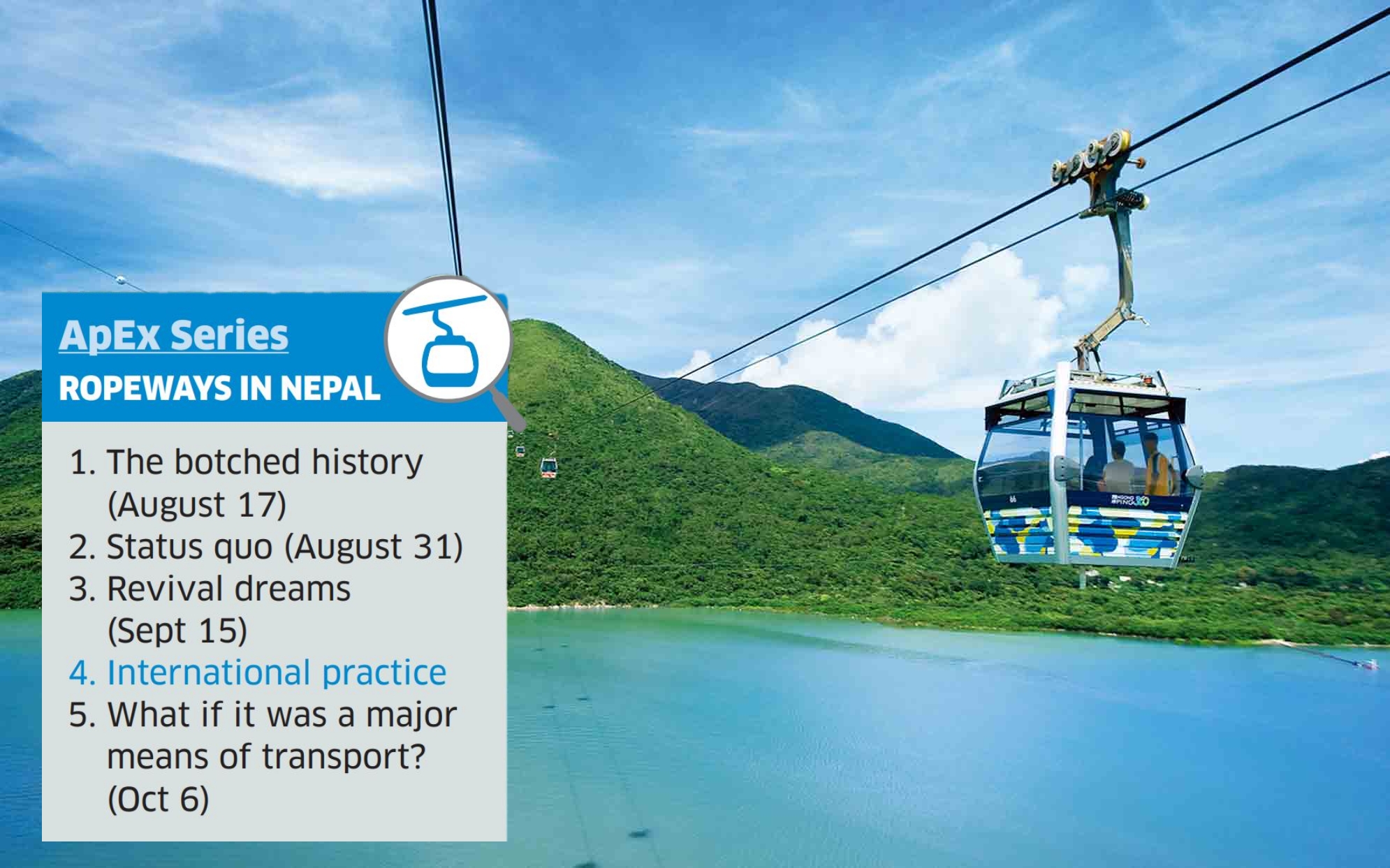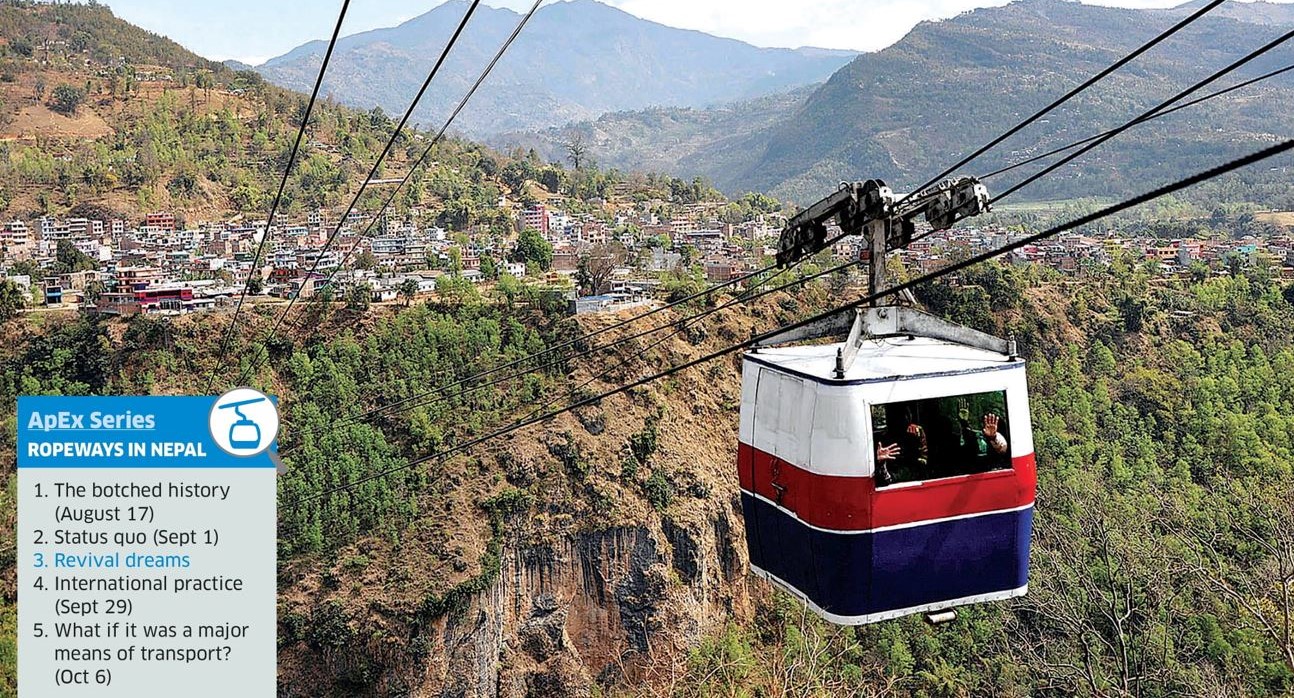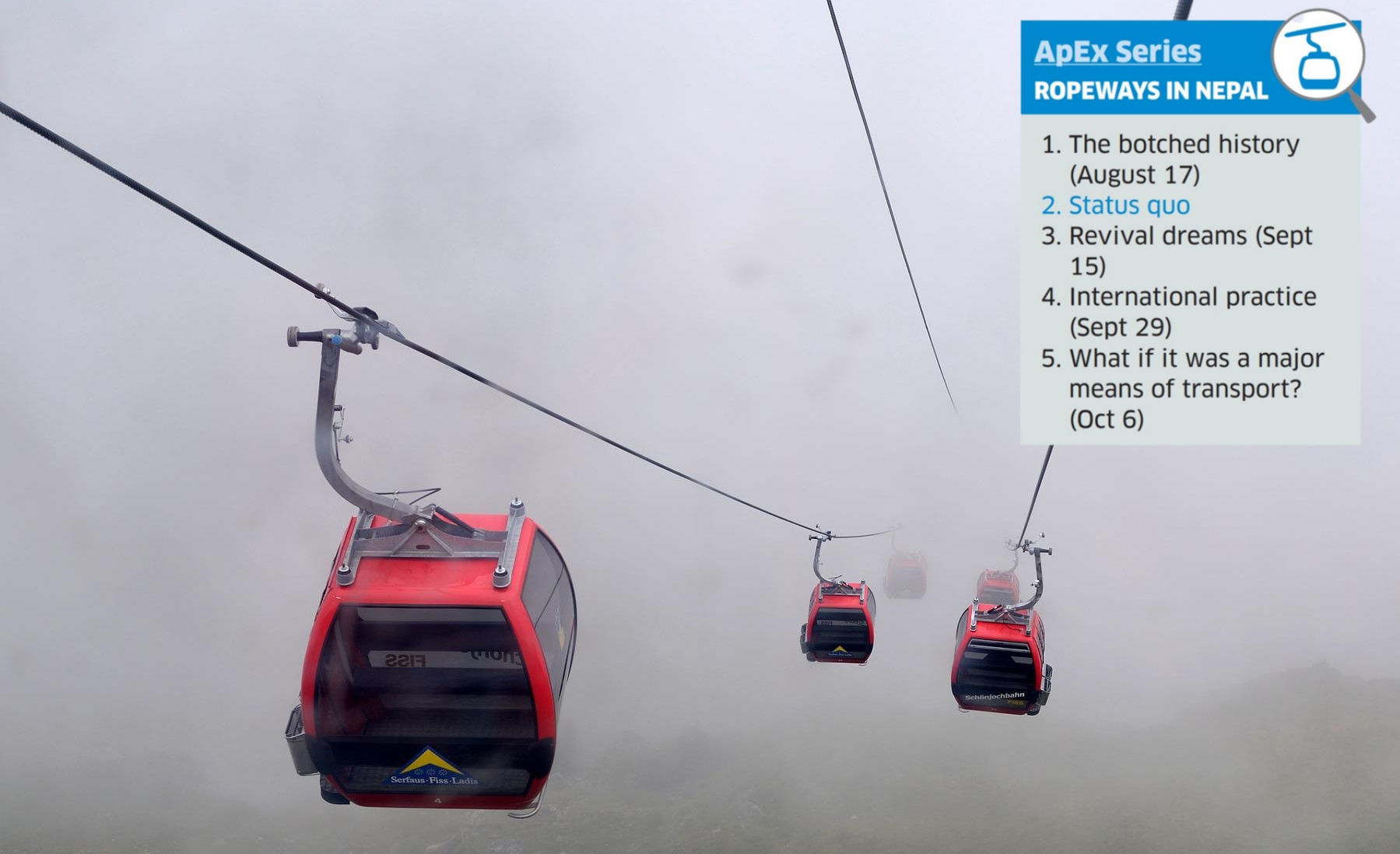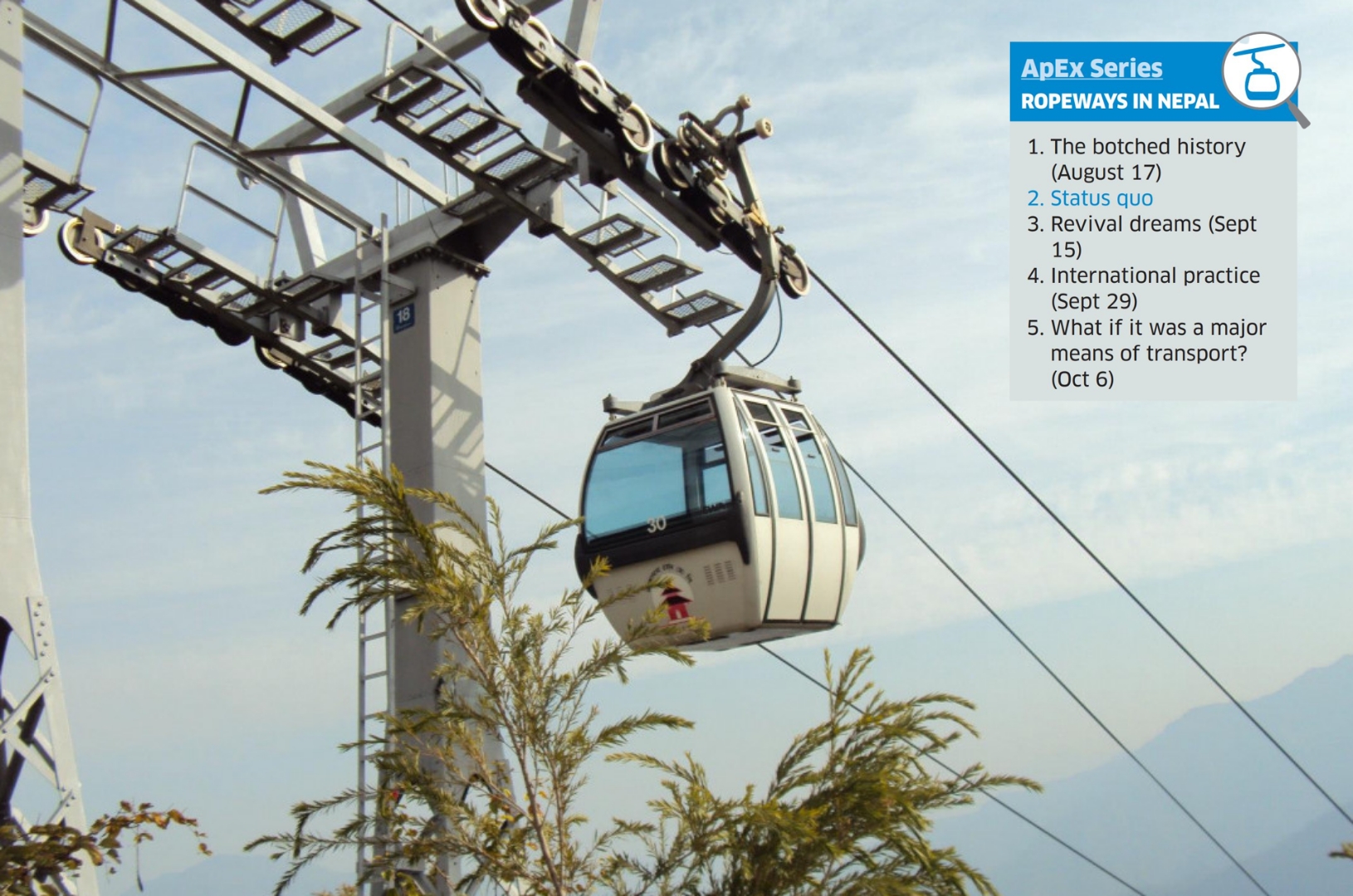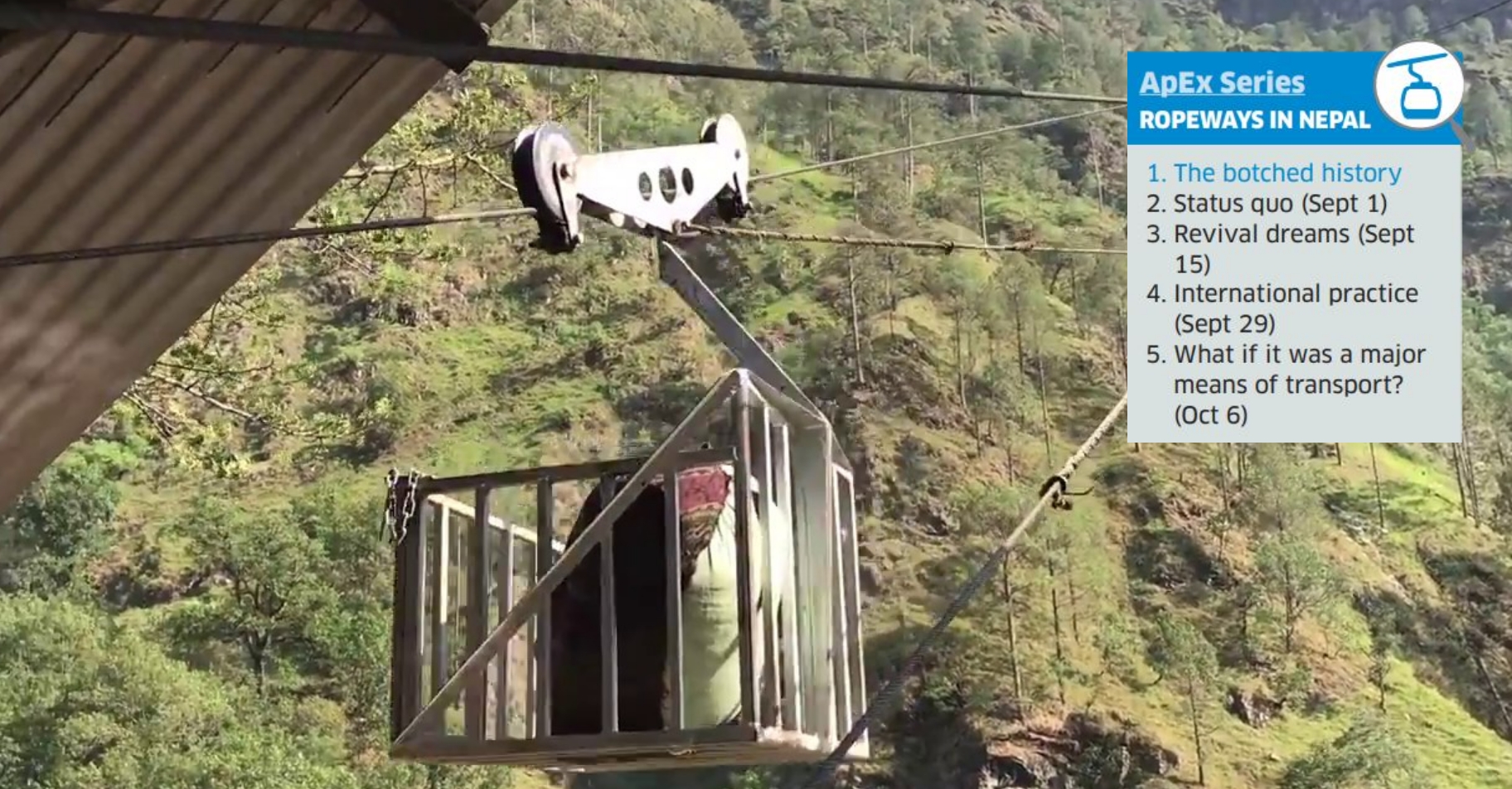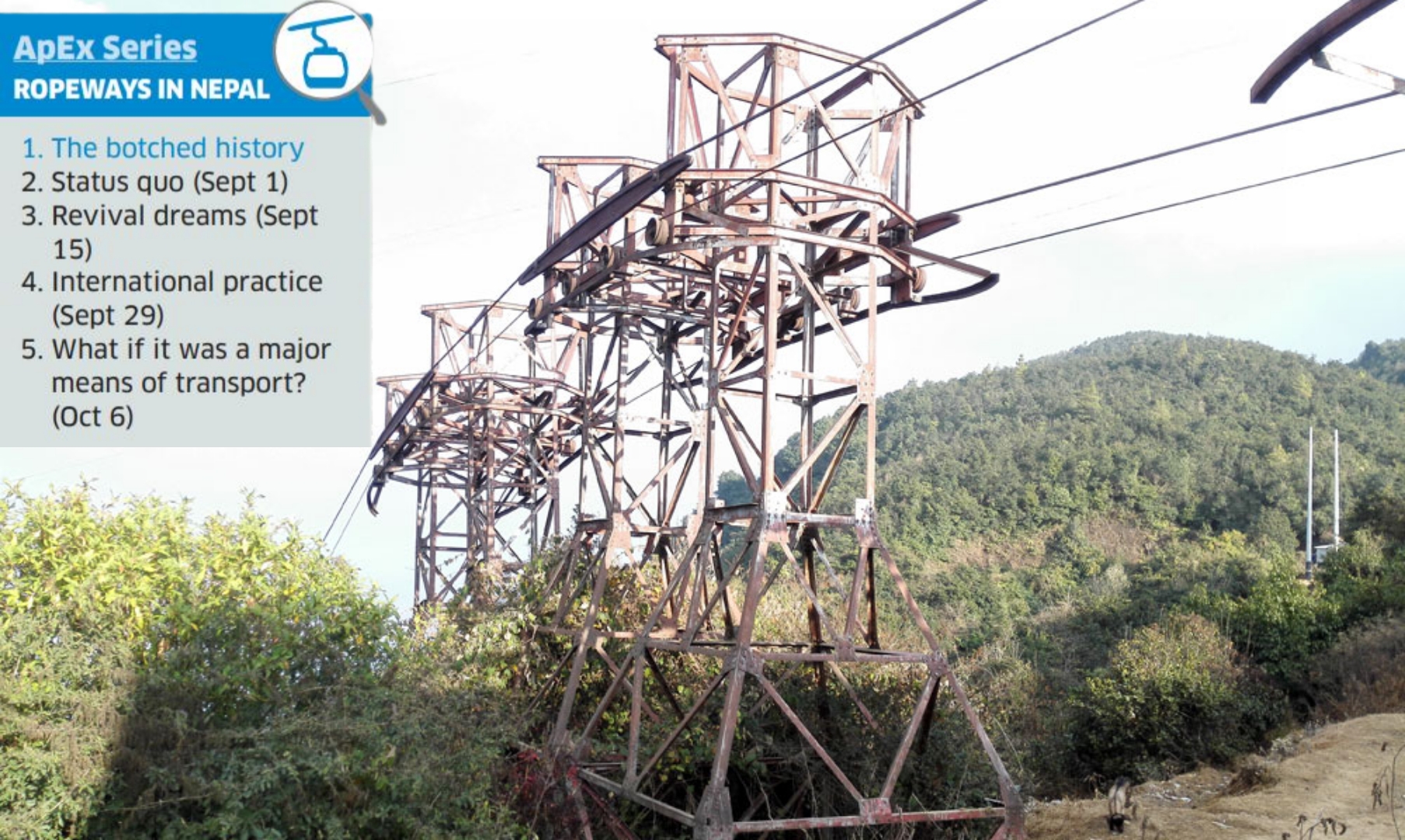ApEx Series: Doing ropeways again
Ropeways can be a vital means of goods-transport in a country like Nepal with its rugged terrains and ever-present risks of roads being blocked by water-induced disasters. Compared to air and road transport, ropeway transport is cheaper too.
The importance of ropeways for Nepal had become evident even a century ago: construction on the country’s first ropeway, the 22-km link between Makawanpur and Kathmandu, had started in 1922 under the orders of Prime Minister Chandra Shamsher. In the latter half of the 20th century, the country had many more ropeway lines.
In 1986, Hetauda Cement Factory started one to ferry limestones. In 1995, the Conservation Ropeway was built at Bhattedanda on the outskirts of Kathmandu valley to transport milk. There were a few other lines as well. But they soon fell into disuse as the national focus shifted to road-building, despite clear evidence of the cost-effectiveness of the ropeways.
Now the discourse on the revival of ropeways in Nepal has again started. We explore the various dimensions of this debate in this five-part, bi-weekly ApEx series.
Part I: Nepal’s most iconic ropeways—now abandoned
Part II: High in potential, low in execution
Part III: Is ropeway revival possible?
Part IV: International ropeway practices and lessons for Nepal
ApEx Series: Nepal’s most iconic ropeways—now abandoned
The year 2022 marks the centenary of the start of ropeway transport in Nepal. It all began with a 22-km cargo ropeway between Makwanpur to Kathmandu. Construction on it started in 1922 and was completed in 1927. A separate four-km Swayambhunath Ropeway was built in 1924 to ferry stones from a quarry in Halchowk all the way to Lainchaur in order to build Rana palaces and roads. These pioneering and other ropeway projects have either disappeared or are no longer in operation. Here we discuss some such ropeways that once played a vital role in transport of goods and as a vehicle for the country’s economic development.
Tri Chandra Nepal Tara Ropeway
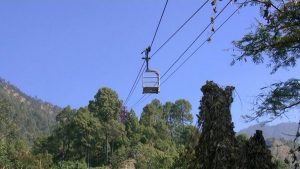
If you have traveled from Kathmandu to Hetauda via Mugling, you might have noticed rusted carriages attached to a cable over the Trisuli River. This ropeway, now abandoned, was among the first of its kind in South Asia. It was commissioned by the then Nepali Prime Minister, Chandra Shamsher, in 1922. The British government had funded the project as a gift to Nepal for its support in the First World War.
The 22-km-long Tri Chandra Nepal Tara Ropeway came into operation in 1927 and it is believed to be one of the first ropeways in the whole of South Asia. It linked the villages of Matatirtha in Kathmandu with Dhorsing in Makawanpur. It was used to transport goods that were brought via Raxaul in India. The consignments were transported from Amlekhgunj in Bara up to Dhorsing in trucks and dispatched to Matatirtha in Kathmandu on the ropeway. A single carriage, traveling at 6.8 km an hour, could bear 254 kg.
In 1964, the ropeway was extended and upgraded with American assistance to transport goods from Hetauda to Kathmandu, as the Tribhuvan Highway used to be frequently obstructed due to landslides. The ropeway was 42-km long and had a hauling capacity of 22 tons an hour. It started falling out of favor in the early 1970s, says Guna Raj Dhakal, chairman of Ropeway Nepal Pvt. Ltd., mainly due to poor planning, mismanagement and political meddling. “Political interference led to overstaffing and at the same time, paucity of technical staff. The infrastructure also could not be maintained as and when necessary,” says Dhakal.
The country’s first and one-of-its-kind ropeway went out of commission following a technical glitch at one of its substations in 1999. The problem could have been fixed for as little as Rs 400,000 but the government of the day chose not to. Tri Chandra Nepal Tara Ropeway, which could transport goods from Hetauda to Kathmandu in four hours, at the cost of 34 paisa a kg, was permanently shut in 2001. At the time of its closure, it used to operate 10 hours a day and employed almost 900 people.
Hetauda Cement Factory Ropeway
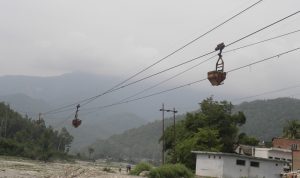
Hetauda Cement, established in 1976, was one of the most successful factories in Nepal, thanks largely to the ropeway system. Starting in 1986, the state-owned factory used the ropeway to transport limestone from a quarry located 11 km away. It could transport 150 tons of limestone in an hour.
Moreover, the cost of ropeway transport was almost half compared to truck-use. The factory thus saved around Rs 2m a year in limestone transport alone. It had no major operational problems other than some technical issues as a result of wear and tear and lack of regular maintenance. The ropeway operated for nearly 17 years before it was abandoned—again, over a fixable issue. According to the book ‘Ropeways in Nepal’, the ropeway was discontinued after one of the frames propping the cable system sank following a landslide. It was permanently shut in 2004.
Meanwhile, the Hetauda Cement Factory, though still in operation, is fast-turning into a white elephant. Factory officials plan to sell the rusted ropeway equipment, which pose risk to the settlements below, but no buyers have come forward.
Bhattedanda Milkway
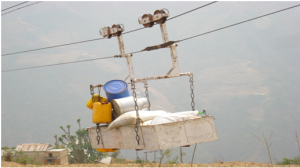
During the 1990s, villagers of the erstwhile Ikudol Village Development Committee in Lalitpur district mostly relied on buffalo farming. But their products including milk lacked market access, as the nearest collection center was at Tinpane, a five-hour walk away. Milk would curdle up by the time villagers reached the center. So they turned the milk into ‘Khuwa’ (a thickened dairy product made by heating up milk), and sold it at Chapagaun, a 10-hour walk away from Ikudol. The process of making Khuwa was labor-intensive and polluting as the villagers burned firewood to boil the milk. So Bagmati Watershed Project (BWP) considered stretching a steel cable across the valley and using it to transport fresh milk in a much shorter time.
In 1995, Conservation Ropeway was built at Bhattedanda to transport milk and clean up the dirty Khuwa business. Every day, 143 households in Ikudol used the ‘milkway’ to collectively sell around 900 liters of fresh milk a day. “Besides milk, the ropeway also benefited vegetable and flower farmers,” says Madhukar Upadhya, a team member of BWP. “The others who profited were merchants, construction contractors, local cooperatives, and development workers who used it occasionally to transport goods”. But traffic on the milkway started declining after 1996. A road to Chhabeli opened up and people could now transport their goods on vehicles.
Still, the Bhattedanda ropeway was in profit and a plan to extend its span was afoot. But the plan never reached its fruition as the local villagers felt that they could do without it. The milkway stopped operating in 2001 after helping the rural economy for more than five years. “Lack of local support plus the new road connectivity doomed it,” says Upadhya. The ropeway was briefly revived when landslides damaged the roadway in the Bhattedanda area in 2002 but was permanently shut down in 2004 following road repairs.
Barpak Community Ropeway
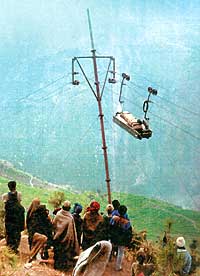
When Bir Bahadur Ghale, a local of Barpak village in Gorkha, went to Hong Kong in 1986, he was fascinated by the cable cars he saw there. He saw them as a convenient way of transporting goods and people in hill areas. He returned home with the dream of building a ropeway in his village. His dream would come true in 1998 when the British Embassy in Kathmandu in cooperation with the Intermediate Technology Development Group (ITDG-Nepal) agreed to help with a goods-carrying ropeway in Barpak.
The ropeway connected Rangrung and Barpak—villages separated by a two-day hike—and had an immediate impact on the people and the local economy. Every day, three tons of goods were transported to Barpak. The ropeway made an average of 20 trips a day between 10 am to 5 pm, and generated an average daily gross income of Rs 1,500. Writing in ‘Ropeways in Nepal’, Ghale mentions that the selling price of transported goods had dropped by Rs 2-3 a kg (and even more) after the ropeway came into operation. For instance, the cost of a four-kg sand-pack went from Rs 8 to Rs 3. The neighboring villages of Laprak and Gumda also benefited from the ropeway.
However, the ropeway was shut down just four months into its operation in May 1999 following an accident when four people riding in the goods carriage died when the hauling cable snapped. Ghale says the ropeway was not meant for transporting passengers but the villagers did not listen. They argued that they too should be allowed to travel via the ropeway as the technical staff did the same for maintenance purposes. The ropeway, which instantly became a profitable enterprise, was permanently discontinued following the fatal accident.
When the victims are further victimized
When Alisha Basnet* visited the cyber bureau of Nepal Police to register an online harassment complaint, the officer in charge went through her phone and then proceeded to question her character. The reason was she had many guys on her social media and contact list.
“The police officer thought I was the one who was deliberately drawing boys’ leering attention,” says the 21-year-old. “I was in a state of utter terror and yet the officer found the whole thing funny.” Basnet returned home without filing the complaint.
Niharika Rajput was 17 when she was drugged, raped and blackmailed. She was impregnated by the rapist and subsequently disowned by her own family. The mother of the now 22-month-baby has since been fighting for justice alone.
She has demanded a DNA test to establish the relation between her baby and its father, her rapist. Over the last two years, Rajput has reached out to the authorities for help and staged a hunger strike pleading her case. But legal help has not been forthcoming as her rapist continues to walk freely.
The 2018 rape-and-murder of 13-year-old Nirmala Panta in Kanchanpur district had sent shock waves across Nepal. Protests erupted for proper investigation after suggestions of police tampering with the evidence to allegedly protect the culprits. Those protests and clamoring for justice for Panta have, over the years, died down and with them the underlying investigation too.
Nepal’s legal system has time and again failed the victims of sexual assault and murder. Without compunction, authorities and the society at large are quick to question the victims’ character whenever there are reports of sexual crimes.
Rajput, too, says the police in a roundabout way suggested that she was asking for it because she had showed up at the station in pants and a t-shirt, a ‘provocative’ dress.
Advocate Samikchya Baskota says victims of sexual crimes do not feel either safe or comfortable with the police.
“The authorities themselves are not welcoming,” she says. “They start by judging the woman because she carries and dresses herself a certain way. No wonder victims are reluctant to report.”
Deputy Inspector General Tek Prasad Rai, Nepal Police spokesperson, claims to have a zero-tolerance policy for such misconduct from officers.
“Every police station has at least one woman officer to forestall such incidents,” he says.
But despite Rai’s claims, there are plenty of incidents whereby law enforcement officers have questioned the character of rape survivors based on their appearance.
Even the first step to justice is traumatizing for girls and women who have been raped or sexually abused, says sociologist Meena Uprety. “How can the survivors hope when they are humiliated for speaking up?”
In some cases authorities refuse to file complaints outright.
Chamila Bhattarai, spokesperson of the National Women Commission, says most such complaints are related to domestic violence.
“We get many domestic violence survivors asking for help after the police refused to register their complaints,” she says.
Advocate Baskota says Nepal’s legal system itself is an obstruction for survivors of sexual crimes and violence.
Even if a complaint is filed and it reaches the court, the justice process is tedious and traumatizing for the survivors, she adds. “Everywhere they go, they are required to explain the incident, which is mentally and emotionally draining for survivors and their families. This is one reason many survivors retract their statements. They feel the justice system is not meant to serve them.”
Advocate Bimala Khadka suggests a fast-track approach in rape cases. She says it is one way to ease the mental and emotional trauma of the victims and reduce the chances of perpetrators influencing the case.
She says perpetrators with money and political clout can wield such undue influence. “Our corrupt judicial system has left many survivors helpless.” she adds.
Baskota agrees. “If the accused has a powerful social status, it is easy for him to prove his innocence.”
The statute of limitations for rape and sexual violence is another reason many survivors cannot get justice.
There have been rallying cries for removing the one-year statute, as many rights activists and women feel that survivors are too traumatized to talk about their harrowing experiences. But nothing has come of it yet.
“Many child victims don’t even know they have been sexually assaulted until much later when they grow up,” says Baskota, while arguing the statute for rape and sexual violence, which used to be just three months until a couple of years ago.
But Rai says incidents of sexual violence survivors coming forward has increased: the number of actual complaints increasing from 1,469 in the fiscal 2017/18 to 2,395 in 2021/22.
“It is a good sign that many survivors are choosing to speak up rather than hiding their trauma because of societal pressure.”
Rai says the earlier the survivor files a complaint, the easier it is for the police to catch the accused.
“Physical evidence plays a major role in identifying the accuser. The bodily trauma and the vaginal swab are essential for investigation,” he says.
Mohna Ansari says this is where the authorities miss the point.
“As important as it is to persecute the criminal, it is as important to protect the survivors,” she says. “The very approach of putting a victim through the ordeal of a vaginal swab and other physical examinations is traumatizing.”
Ansari is of the view that the survivor’s statement alone should be enough to pursue an investigation. “It should be up to the accused to prove his innocence.”
Sociologist Uprety says the ultimate responsibility of preventing crimes against women and delivering them justice, however, lies with the society.
The instances of rape and violence survivors being humiliated in police stations, she says, are the result of the society’s patriarchal mindset.
“We live in a society where the survivors are forced to drop the charges and retract their statements by their own families and communities,” she says. “This has to change.”
(*Name changed to protect privacy)
How patriarchy promotes violence against women
A 13-year-old girl is raped. The policeman who is filing the complaint tells her she has a reputation for being sexually active. A gang-rape victim is questioned if she enjoyed ‘having sex’ with any of her rapists. At a school in Chitwan, the administration refuses to open a box of complaints by students after a girl is sexually abused by one of their teachers. They are told not to spread rumors. In Morang, an angry mob kills a woman police constable. She is on her way to arrest a teacher named Manoj Poudel who is involved in three incidents of sexual abuse.
Our society has always granted immunity to men. When a woman suffers abuse, she is told to let it go, not to create a fuss, or is blamed for what she had to go through—she must have done something to get unwarranted attention; dressed inappropriately perhaps or gone out alone at night? This promotes violence and limits women’s access to justice, says Lily Thapa, women’s rights activist and member of the National Human Rights Commission (NHRC). Worse, women choose to suffer in silence rather than go through the ordeal of speaking up and being stigmatized.
“The country’s institutions are run on patriarchal ideologies and women, as a result, are oppressed. Our socialization process also promotes gender discrimination, which ultimately manifests in mental, physical or emotional abuse,” she says. Thapa adds that gender stereotypes like ‘the father is the head of the household’, and ‘the mother cooks food at home’ litter our school curriculum. The role of the man as the strong provider and the woman as the meek caretaker is imprinted on children’s minds early on. Gender dynamics shape how we think and behave and it’s difficult to unlearn this later on in life and accept that men and women are equal.
Manju Khatiwada, undersecretary at NHRC, says our system is designed in men’s favor. From having different sets of rules for sons and daughters to political protection for criminals, men enjoy many liberties. The society, Khatiwada says, is highly tolerant of men’s mistakes while making no allowances whatsoever for women’s occasional slip-ups. If a man, say, has an affair, people character-assassinate the woman he is seeing.
A friend recently confided in me that a reputed corporate house she works at in Lalitpur fired a woman when she was caught having an affair with a married man. The man still works at the same office. His wife publicly attacked the woman when she found out about the affair, calling her all sorts of names while saying nothing to her husband. She claimed the woman had ‘honey-trapped’ her husband. Similarly, multiple women have accused a renowned cardiologist in Kathmandu of sexual harassment but no action has ever been taken against him. Rather, the hospital he works at covers up the incidents, sometimes even making his subordinates take the blame.
“We have all these ideas about how women should speak, dress, and behave but none for men. Instead, all kinds of excuses are made for men’s bad behavior,” says Khatiwada. The society’s patriarchal values have given men the confidence that they can get away with disrespecting women and violating their rights. According to a report by the United Nations Population Fund, 48 percent of Nepali women have faced some form of violence at some point in their lives; 15 percent of these women have faced sexual violence. The actual proportion is believed to be higher as the stigma of being a victim and the ensuing social ostracization keep many women from reporting violence.
Kamal Phuyal, sociologist, says most women are socialized to think of abuse and violence as their fate. He adds that women have inherited and internalized the culture of silence from their mothers and grandmothers. Many still think abuse is a domestic issue and that talking about it will bring shame to the family. Our family, education, society, and legal system support a culture of women’s dominance. Children grow up seeing gender imbalance at home. Schools don’t focus on moral education. Our society controls women in the name of religion and tradition. The legal system, with its many loopholes and red tape, acts late, if at all.
Phuyal says people are generally governed by various codes of conduct—be it social, religious, or legal. But, in our society, he laments, people make their own arbitrary rules. There’s a lack of conscience and responsibility. In rural areas, people still fear any misconduct on their part will hurt their reputation or negatively impact their families. This fear of societal scorn is lacking in urban areas. That coupled with a weak implementation of laws instigates violence. “Violence escalates when people believe they can get away with anything,” says Phuyal.
Mistreatment of women usually begins at home, though it might not be blatantly obvious at times. Women have little or no say in family matters. The male members of the family keep tabs on their whereabouts and spendings. They are second-class citizens in their own homes. The emotional and mental abuse goes unnoticed and many women suffer from depression and other mental health issues, says Rumi Rajbhandari, founder of Astitwa, an organization that works for the rehabilitation of burn violence survivors. Sometimes, this escalates to physical violence.
“Our male-dominated society imposes strict gender norms that dictate how we behave and interact and that puts women at a disadvantage,” says Rajbhandari. Men, she adds, often have an inflated sense of self and when things don’t go their way, their egos get hurt. Burn violence and rapes are usually the result of men not being able to take a ‘no’ for an answer, she says.
Raunaq Singh Adhikari, advocate, says there are many laws to protect women and ensure their rights but they are largely limited to paper. Our justice system needs a fast-track mechanism for cases of violence. The Supreme Court, in 2014, called for it among other changes but it has yet to be implemented. “It’s high time we addressed the legal issues that victimize women,” he says.
Lochana Sharma, counseling psychologist, on the other hand, says women need moral support in addition to legal help. In most cases, women fear backlash from their families, relatives, and neighbors and hesitate to share their stories. “Women need to be supported at home for them to be able to take a stand when needed. But sadly, our patriarchal mindset pulls them down. They are told to be silent and to compromise, often at the cost of their mental wellbeing,” says Sharma.
For women to live a dignified life, Undersecretary Khatiwada adds, what we need is a zero-tolerance policy for violence and a change in our socialization process. Activist Thapa agrees. She says the change must start from our homes. We must groom our children to respect others despite gender, class, religion and other manmade differences. Sociologist Phuyal says our education system needs to be reformed to include gender studies in the school curriculum. That’s the only sustainable solution to curb gender disparity and violence, he says.

